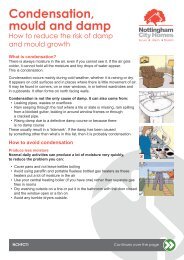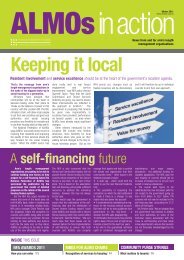Secure Warm Modern - Nottingham City Homes
Secure Warm Modern - Nottingham City Homes
Secure Warm Modern - Nottingham City Homes
You also want an ePaper? Increase the reach of your titles
YUMPU automatically turns print PDFs into web optimized ePapers that Google loves.
The ‘<strong>Secure</strong> <strong>Warm</strong><br />
<strong>Modern</strong>’ programme<br />
in <strong>Nottingham</strong><br />
Decent <strong>Homes</strong> impact study:<br />
Employment and the local economy
Acknowledgement<br />
The Decent <strong>Homes</strong> Impact Study is a joint project between <strong>Nottingham</strong> <strong>City</strong> <strong>Homes</strong> and <strong>Nottingham</strong><br />
Business School, <strong>Nottingham</strong> Trent University. This Partnership received fi nancial support from the<br />
Knowledge Transfer Partnerships programme (KTP).<br />
KTP aims to help businesses to improve their competitiveness and productivity through the better use<br />
of knowledge, technology and skills that reside within the UK Knowledge Base. KTP is funded by the<br />
Technology Strategy Board along with the other government funding organisations.<br />
This project is also funded by One <strong>Nottingham</strong>.<br />
With thanks to NCH’s contractor partners for their contribution to this research: Bullock, Frank<br />
Haslam Milan, Nationwide Windows & Doors, SPI, Vinshire Plumbing and Heating Limited, and<br />
Wates Living Space.<br />
<strong>Nottingham</strong> <strong>City</strong> <strong>Homes</strong><br />
Amanda Schofi eld, Director of Strategy and Partnerships<br />
Mark Johnson, Director of Property Services<br />
Steve Hale, Assistant Director of Asset Management<br />
Dan Lucas, Strategy Development Offi cer<br />
Steve Edlin, Head of Service – Capital Programme<br />
<strong>Nottingham</strong> Business School<br />
Professor Alistair Mutch<br />
Dr Néstor Valero-Silva<br />
Dr John Buglear<br />
KTP Adviser<br />
Philippa Ryan<br />
Housing Investment Impact Analyst (KTP Associate)<br />
Alice Jones<br />
alice.jones@nottinghamcityhomes.org.uk<br />
January 2012<br />
www.nottinghamcityhomes.org.uk/<br />
improving_your_home/secure_warm_modern/impact_study.aspx<br />
2
Contents<br />
Executive summary ..............................................................<br />
1. Introduction ......................................................................<br />
2. Approach .........................................................................<br />
3. Local multiplier effect of <strong>Secure</strong> <strong>Warm</strong> <strong>Modern</strong> ...........<br />
4. Business benefits ..............................................................<br />
5. Skills and training .............................................................<br />
6. Community legacy benefits ...........................................<br />
7. Conclusions and recommendations ..............................<br />
Page<br />
5<br />
9<br />
13<br />
17<br />
23<br />
24<br />
27<br />
28<br />
3
Executive summary<br />
Background to the project<br />
<strong>Nottingham</strong> <strong>City</strong> <strong>Homes</strong>, in partnership with <strong>Nottingham</strong> Trent University,<br />
is conducting a two-year impact study on the wider social benefits of the<br />
Decent <strong>Homes</strong> programme, known in <strong>Nottingham</strong> as the <strong>Secure</strong> <strong>Warm</strong><br />
<strong>Modern</strong> programme.<br />
The research investigates the impact of this signifi cant investment in <strong>Nottingham</strong>’s council housing<br />
properties on social outcomes such as crime, health and wellbeing, the environment, and fuel<br />
poverty. The report focuses on the impact of the <strong>Secure</strong>, <strong>Warm</strong>, <strong>Modern</strong> programme on spending<br />
in the local economy and its effect on employment and training.<br />
The <strong>Secure</strong> <strong>Warm</strong> <strong>Modern</strong> programme in <strong>Nottingham</strong><br />
<strong>Nottingham</strong> <strong>City</strong> <strong>Homes</strong>’ (NCH) <strong>Secure</strong> <strong>Warm</strong> <strong>Modern</strong> programme aims to bring<br />
<strong>Nottingham</strong>’s 28,300 council homes up to and above the national Decent <strong>Homes</strong> standard.<br />
This requires a significant capital investment in the housing stock between 2008-2015,<br />
delivered under the following streams of work:<br />
• <strong>Secure</strong>: Upgrading windows in 15,300 properties to ‘<strong>Secure</strong> by Design’ double-glazed units<br />
plus replacing old doors<br />
• <strong>Warm</strong>: Upgrading 19,700 heating systems to full central heating with A-rated boilers<br />
• <strong>Modern</strong>: Replacing 17,000 kitchens and 12,700 bathrooms, plus electrical rewires.<br />
This is a large capital development project within <strong>Nottingham</strong>, with a total budget of £187m.<br />
It therefore represents a signifi cant fi nancial injection into the construction industry, along with<br />
associated impacts such as increased employment, training and stimulation of the local economy.<br />
The Sustainable Communities Strategy, The <strong>Nottingham</strong> Plan to 2020, 1 is the city’s long-term plan<br />
for maintaining its economic competitiveness, and ensuring that all local residents benefi t from this.<br />
A strategic aim of the <strong>Nottingham</strong> Plan is to ‘tackle poverty and deprivation by getting more local<br />
people into good jobs’, including targets to increase employment and thus reduce the number<br />
of workless households, increase skills and qualifi cations required to progress in work and earn<br />
more, and thereby signifi cantly reduce poverty and deprivation. These factors are particularly relevant<br />
for <strong>Nottingham</strong>, which has higher unemployment and lower skills than the national average.<br />
The construction sector is the fi fth-largest employer in <strong>Nottingham</strong>, and was badly hit by the<br />
economic downturn and reduction in house building. 2 <strong>Nottingham</strong> <strong>City</strong> Council has therefore pledged<br />
to focus on creating local jobs in the construction industry, by ensuring that infrastructure<br />
developments that are planned for the city are enabled to draw on local employment sources.<br />
1. One <strong>Nottingham</strong> (2009). Available at:<br />
http://www.nottinghamcity.gov.uk/onenottingham/index.aspxarticleid=5486<br />
2. <strong>Nottingham</strong>’s Local Economic Assessment (2011). Available at: http://www.nottinghaminsight.org.uk/<br />
5
The impact of the <strong>Secure</strong>, <strong>Warm</strong>, <strong>Modern</strong> programme on the local economy and employment was<br />
measured using the New Economic Foundation’s Local Multiplier 3 tool, which measures how money<br />
is spent and re-spent within a defi ned local area. The impact on skills and training, business<br />
development and on local communities was also measured using a range of indicators.<br />
Key fi ndings<br />
Over the course of the <strong>Secure</strong>, <strong>Warm</strong>, <strong>Modern</strong> programme from 2008 to 2015, NCH will receive<br />
just over £187m in funding from the Department for Communities and Local Government (under the<br />
national Decent <strong>Homes</strong> programme) and from <strong>Nottingham</strong> <strong>City</strong> Council. The Local Multiplier 3 (LM3)<br />
model analyses how much of this spending remains within the local economy, and is re-spent by local<br />
people and businesses. The local areas are defi ned here as, fi rstly, within the boundaries<br />
of <strong>Nottingham</strong> city and, secondly, within the county of <strong>Nottingham</strong>shire (including the city).<br />
In the last fi nancial year (2010/11) 560 people were employed on the SWM programme, including<br />
NCH staff, contractors and sub-contractors. Of these employees, 28 per cent live within <strong>Nottingham</strong><br />
city, and 51 per cent within <strong>Nottingham</strong>shire (including the city).<br />
The programme is delivered by seven contractor partners, only one of which (NCH’s Direct Labour<br />
Organisation) is based in the city. The remaining contractors are part of larger regional or national<br />
construction companies, which specialise in the delivery of large-scale capital projects in the social<br />
housing sector. The profi le of the construction industry in the region, with very few medium<br />
or large-sized companies with the required specialist expertise, restricts the choices NCH has<br />
in selecting its contractors. However, each of the companies has established an operational base<br />
within the city, and around 30 per cent of contractor staff live in <strong>Nottingham</strong>. They also make use<br />
of local sub-contractors and suppliers; 23 per cent of sub-contractors are based within the city and<br />
53 per cent within the county (including those in the city), and 52 per cent of the spend with suppliers<br />
is with businesses located in the city.<br />
The LM3 score shows that every £1 of the initial investment from the <strong>Secure</strong>, <strong>Warm</strong>, <strong>Modern</strong><br />
programme generates £1.36 within <strong>Nottingham</strong> city, or £1.46 spending across <strong>Nottingham</strong>shire<br />
(including the city). This means that every £1 that is spent on SWM generates an additional 36p<br />
of spending in <strong>Nottingham</strong> city, due to the way it is re-spent by local businesses and people; when<br />
the rest of <strong>Nottingham</strong>shire is included, the resultant spending increases to 46p.<br />
Therefore, the £37.6m spent on SWM in 2010/11 generated £54.9m spending in <strong>Nottingham</strong>shire,<br />
i.e., the original investment plus an additional £17.3m spending in <strong>Nottingham</strong>shire. Of this additional<br />
spending, £13.5m was spent within the <strong>Nottingham</strong> city boundaries.<br />
The SWM programme has additional social benefi ts through the training and skills development<br />
it encourages. The ‘One in a Million’ scheme requires that contractors take on an apprentice for every<br />
£1m of their contract. This has created 105 Apprenticeships to date, with a target to create 200<br />
Apprenticeships by the end of the programme in 2015. The training and qualifi cations gained through<br />
the Apprenticeship are valued in the job market, and are recognised through higher earnings and<br />
employment opportunities for the individual throughout their career, compared to those<br />
with lower or no formal qualifi cations. The total social value of these 105 Apprenticeships,<br />
in terms of increased earnings over their lifetime, amounts to £12.9m.<br />
6
NCH staff are also supported though relevant training and qualifi cations. Since the start of the SWM<br />
programme in 2008, staff on the team have undertaken over 2,000 hours of training (an average<br />
of 56 hours per staff member) and completed over 400 training courses. This includes both<br />
internal and e-learning courses, as well as eight externally accredited qualifi cations. The total cost<br />
of this investment in training for the SWM team is around £33,000. However, the returns to this<br />
training are high, particularly for higher-level vocational and craft qualifi cations. For example, the<br />
three NCH staff who have completed a Level 3 <strong>City</strong> and Guilds certifi cate are each estimated to earn<br />
£48,000-£74,000 more than others with only a Level 1 or 2 qualifi cation, over their working career.<br />
Delivering a large-scale capital programme such as <strong>Secure</strong>, <strong>Warm</strong>, <strong>Modern</strong> has helped to build the<br />
organisational capacity of both NCH and contractor partners. Key Performance Indicators (KPIs)<br />
show that the programme has been delivered on time and within budget, and that customer<br />
satisfaction has been increasing throughout. Such evidence of the organisation’s capabilities has<br />
contributed to NCH and partners winning a further £12m for 2010-12 to deliver energy effi ciency<br />
improvements to the stock.<br />
Conclusions and recommendations<br />
The <strong>Secure</strong>, <strong>Warm</strong>, <strong>Modern</strong> programme represents a signifi cant investment in the local council<br />
housing stock, and this research has aimed to measure its wider social impact in terms of the effects<br />
on the local economy and employment.<br />
The LM3 analysis shows that the overall score for SWM is at the lower end of the possible range<br />
of LM3 scores (the lowest possible score being £1 and the highest around £2.20). This is mainly due<br />
to the non-local nature of the majority of the main contractors, most of whom are part of a larger<br />
regional/national company.<br />
Although the multiplier score is fairly low, the size of the spending on the SWM programme overall<br />
means that the multiplied effect on the local economy is signifi cant. This also means that a small<br />
increase in the local multiplier score could bring considerable extra resources to the city. For<br />
example, if the current multiplier for <strong>Nottingham</strong> city of 1.36 were to continue for the remainder<br />
of the programme, this would generate an additional £37m spending within the city over this period<br />
(2011-15). However, if the multiplier were to increase by just 1p for every £1 spent to 1.37 (for<br />
example, by increasing spending with local sub-contractors by 5 percent), this would generate<br />
a further £1m spill-over into the city’s economy for the remainder of the programme. This statistic<br />
demonstrates how small changes in procurement arrangements could make a large difference<br />
to <strong>Nottingham</strong>’s economy.<br />
The recommendations provide considerations for NCH: to build on existing initiatives and<br />
commitment to playing a positive role in the local economy and developing training and skills, and<br />
to develop a strategic approach to sustainable procurement that will maximise the potential positive<br />
impact of all future investment programmes.<br />
7
Recommendation 1:<br />
Develop a sustainable procurement strategy and toolkit to embed social benefits into all<br />
purchasing and contracting arrangements.<br />
Recommendation 2:<br />
Work with contractors and partners to maximise the positive impact of current and<br />
ongoing programmes.<br />
Recommendation 3:<br />
Establish monitoring with contractors to identify the destination of apprentice leavers,<br />
as a first step towards supporting apprentices beyond the completion of their training.<br />
Recommendation 4:<br />
Consider conducting a Local Multiplier 3 analysis on other sections of the company,<br />
such as repairs and maintenance, and housing support services.<br />
The report has shown that the <strong>Secure</strong>, <strong>Warm</strong>, <strong>Modern</strong> programme has a signifi cant positive effect<br />
on the local economy, employment and skills. It has also demonstrated how further benefi ts could<br />
be achieved through small changes to the supply chain, ensuring that the Decent <strong>Homes</strong> funding<br />
stays within, and has an exponential effect upon, the local economy. NCH is therefore able<br />
to contribute to the aims of <strong>Nottingham</strong>’s Sustainable Communities Strategy by providing jobs<br />
and training to local people.<br />
8
1. Introduction<br />
<strong>Nottingham</strong> <strong>City</strong> <strong>Homes</strong>, in partnership with <strong>Nottingham</strong> Trent University, are conducting a two-year<br />
impact study on the wider social benefi ts of the Decent <strong>Homes</strong> programme, known in <strong>Nottingham</strong><br />
as the ‘<strong>Secure</strong>, <strong>Warm</strong>, <strong>Modern</strong>’ programme. The research investigates the impact of this signifi cant<br />
investment in <strong>Nottingham</strong>’s council housing properties on such social outcomes as crime, health and<br />
wellbeing, the environment, and fuel poverty.<br />
This report focuses on the impact of the <strong>Secure</strong>, <strong>Warm</strong>, <strong>Modern</strong> programme on spending in the local<br />
economy and its effect on employment and training.<br />
1.1. The <strong>Secure</strong>, <strong>Warm</strong>, <strong>Modern</strong> programme<br />
<strong>Nottingham</strong> <strong>City</strong> <strong>Homes</strong>’ (NCH) <strong>Secure</strong>, <strong>Warm</strong>, <strong>Modern</strong> programme aims to bring <strong>Nottingham</strong>’s<br />
28,300 council homes up to and above the national Decent <strong>Homes</strong> standard.<br />
This requires a significant capital investment in the housing stock between<br />
2008-2015, including:<br />
• <strong>Secure</strong>: Upgrading windows in 15,300 properties to ‘<strong>Secure</strong> by Design’ double-glazed units<br />
plus replacing old doors<br />
• <strong>Warm</strong>: Upgrading 19,700 heating systems to full central heating with A-rated boilers<br />
• <strong>Modern</strong>: Replacing 17,000 kitchens and 12,700 bathrooms, plus electrical rewires.<br />
This is a large capital development project for the city, with a total budget of £187m. It therefore<br />
represents a signifi cant fi nancial injection into the construction industry, along with associated<br />
impacts such as increased employment, training, and the stimulation of the local economy.<br />
NCH currently works with seven constructor partners, each specialising in a stream of the work:<br />
<strong>Secure</strong> <strong>Warm</strong> <strong>Modern</strong><br />
NCH is also the lead and Accountable Body for Effi ciency East Midlands (EEM) procurement<br />
consortium. EEM membership includes 17 social housing providers within the region, working<br />
collaboratively to secure effi ciencies in the procurement of asset management services. These<br />
effi ciencies include both cost savings and also ‘non-cashable’ savings such as local labour and<br />
Apprenticeships. Many of the materials for the SWM programme were procured through the<br />
EEM consortium.<br />
9
1.2. Employment, skills and the local economy<br />
Employment and skills<br />
The ‘up-skilling’ of the UK workforce is seen by the government as a key factor in driving long-term<br />
growth and creating a fairer society. Skills are important for the economy as they lead to increasing<br />
productivity; however, they are also important to the individual, providing access to employment and<br />
as a means of social mobility. A central element of the recent skills policy has been the expansion<br />
of the Apprenticeship programme, with the Government announcing an increase in funding to £1.4bn<br />
for 2011/12 to create an additional 100,000 Apprenticeship places by 2014. 3<br />
Reducing long-term unemployment is another important policy focus. The Government’s ‘Work<br />
Programme’ is the overall strategy for addressing long-term unemployment; under this programme<br />
regional providers are contracted to provide intensive support to the long-term unemployed to support<br />
them into a job and sustained employment. There is particular concern regarding the more than one<br />
million young people who are not in education, training or employment (NEET). Under the previous<br />
Government, the Future Jobs Fund supported community-focused job placements for young people,<br />
and the current Government has recently announced a £1 billion scheme to subsidise employers<br />
providing work and training programmes for people aged 16-24. 4<br />
One <strong>Nottingham</strong>’s Sustainable Communities Strategy (SCS) ‘The <strong>Nottingham</strong> Plan to 2020’ sets out<br />
the effect of economic growth on the city’s residents and communities. This includes the strategic aim<br />
to ‘tackle poverty and deprivation by getting more local people into good jobs’.<br />
The specific aims under the ‘Working <strong>Nottingham</strong>’ strategic theme are to have:<br />
• More people in employment and fewer workless households<br />
• More adults with the appropriate skills and qualifi cations able to progress in work and earn more<br />
• Signifi cantly reduced poverty and deprivation.<br />
Building on this aim, the <strong>City</strong> Council in <strong>Nottingham</strong> has pledged to create ‘local jobs for local<br />
people’ by:<br />
• Increasing the employment of local people and ensuring suppliers sign up to and deliver<br />
the jobs pledge<br />
• Improving workforce development (training and skills), ensuring good conditions of employment,<br />
and ensuring suppliers sign up to and deliver the skills pledge<br />
• Making sure suppliers use apprenticeships and training that lead to secure employment<br />
for local people.<br />
3. Department for Innovation, Business and Skills (2011). Available at:<br />
http://www.bis.gov.uk/news/topstories/2011/Feb/national-apprenticeship-week-2011<br />
4. Department for Work and Pensions (2011). Available at:<br />
http://www.dwp.gov.uk/newsroom/press-releases/2011/nov-2011/dwp132-11.shtml<br />
5. <strong>Nottingham</strong> Labour Manifesto (2011). Available at:<br />
http://open.nottinghamcity.gov.uk/comm/download3.aspdltype=inline&filename=28136/<br />
LabourManifesto.pdf<br />
10
To support these initiatives the Council established the ‘<strong>Nottingham</strong> Jobs Plan’, which aims to create<br />
opportunities locally for employment and training for those who are out of work. Leading by example,<br />
since 2003 the <strong>City</strong> Council has increased the proportion of its own workforce who also live in the city<br />
from 43 per cent to 54 per cent, and has ring-fenced all entry-level jobs and training opportunities for<br />
local people. The Leader of the <strong>City</strong> Council has pledged to continue to increase the proportion<br />
of the Council’s workforce from the city. 5 In addition, the Council took up the opportunity provided<br />
by the Future Jobs Fund to create 1,000 job placements for young people in the city in 2011.<br />
Addressing employment and skills issues is particularly relevant for <strong>Nottingham</strong>, which has higher<br />
unemployment and lower skills than the national average. For example, unemployment is higher<br />
in <strong>Nottingham</strong> than on average in the UK (at 6.2 per cent in <strong>Nottingham</strong> <strong>City</strong> in March 2010,<br />
compared to 4.2 per cent UK-wide). There is, however, considerable variation among areas of the<br />
city and groups of people; unemployment is over ten per cent in Aspley, Bestwood, Bulwell and<br />
St Ann’s, with young people and those looking for low-skills employment representing around one<br />
third of current job seekers. Of <strong>Nottingham</strong>’s population, 77.5 per cent is economically active (i.e.,<br />
in work or unemployed but actively seeking work), compared to 78.7 per cent across the UK.<br />
Workers in <strong>Nottingham</strong> earn, on average, less than the UK median. The median gross weekly pay<br />
of full-time workers resident in <strong>Nottingham</strong> is £416.70, compared with £496 in England.<br />
Average qualifi cation levels have increased across <strong>Nottingham</strong>shire over the last decade yet remain<br />
below England averages. In <strong>Nottingham</strong> and <strong>Nottingham</strong>shire in 2008, 67 per cent of residents aged<br />
between 19 and retirement age were qualifi ed to at least Level 2, compared to 69 per cent in England<br />
overall. A greater proportion of <strong>Nottingham</strong> and <strong>Nottingham</strong>shire residents have no qualifi cations than<br />
the national average (13.3 per cent compared to 11.9 per cent).<br />
Local economic development<br />
The priority sectors for economic development identifi ed in the <strong>Nottingham</strong> Plan include the public<br />
sector (along with science and new technology, fi nance and business services, retail, leisure and<br />
tourism, and the creative industries). While the housing/construction industry is not among the priority<br />
sectors, <strong>Nottingham</strong> <strong>City</strong> Council has pledged to focus on creating local jobs in the construction<br />
industry, by ensuring that infrastructure developments that are planned for the city are enabled<br />
to draw on local employment sources.<br />
Wider regional economic development will be supported by the newly formed Local Economic<br />
Partnership, which includes <strong>Nottingham</strong> <strong>City</strong>, along with <strong>Nottingham</strong>shire, Derby and Derbyshire.<br />
The LEP will have responsibility for strategic coordination across the region, supplying the necessary<br />
evidence base to inform decisions in areas such as employment and skills, infrastructure and<br />
planning. The LEPs replace the Regional Development Agencies, which were disbanded following<br />
the election of the coalition government.<br />
The housing construction sector in the area<br />
The shape of the housing construction industry affects the choices available to NCH<br />
in delivering a signifi cant investment programme such as <strong>Secure</strong>, <strong>Warm</strong>, <strong>Modern</strong>. NCH’s<br />
decision to outsource the construction work and to have an elemental programme (rather<br />
than a whole-house approach) means that it requires specialist contractor partners with<br />
the capacity and experience in delivering a large-scale programme in a social<br />
housing context.<br />
11
While the construction sector is a signifi cant part of the UK economy, supporting around eight per<br />
cent of GDP, work on public sector housing accounts for a small proportion of the total output; in 2009<br />
new-build public housing accounted for 3.6 per cent of the total construction output in Great Britain,<br />
and repairs and maintenance in the sector accounted for 8.9 per cent. The industry as a whole was<br />
one of the hardest hit during the recession, with an estimated 375,000 job losses between 2008-10. 6<br />
Since 2007, new building in social housing has decreased by ten per cent; however, public housing<br />
repairs have continued to grow 7 (supported by government funding through the Decent<br />
<strong>Homes</strong> programme).<br />
The construction industry in the East Midlands is small, with few larger construction fi rms based<br />
in the region. For example, the East Midlands region has the second-smallest construction industry<br />
of all the nine English regions, in terms of the number of construction enterprises (8 per cent of total<br />
for England) and employment (7.4 per cent England total). 8 The East Midlands also has the smallest<br />
number of medium/large construction employers (i.e., with 60 or more employees) of all the English<br />
regions, with only four per cent of the England total of fi rms this size being registered in the East<br />
Midlands. Over a third of construction fi rms in the East Midlands are sole traders (with only<br />
one employee). 9<br />
Within <strong>Nottingham</strong>shire, however, construction is relatively important in the local economy and is the<br />
fi fth-largest source of employment (8 per cent of employment). It was one of the fastest-growing<br />
sectors before the recession, in part refl ecting the boom in house building, but was severely affected<br />
by the recession, contracting by 6 per cent between 2006-2007 – more than twice the decline<br />
in England. 10<br />
The construction industry is strongest (in terms of number of enterprises and employment) in the<br />
South-East, London and East. The largest concentrations of medium/large fi rms (60 employees<br />
or more) are in the South-East and North-East.<br />
The overall picture therefore is that the East Midlands region as a whole has few large construction<br />
companies, and is dominated by smaller fi rms or sole traders. Within <strong>Nottingham</strong>shire this accounts<br />
for a signifi cant amount of employment. This has implications for the pool of potential contractors<br />
to be drawn on by a large capital programme in <strong>Nottingham</strong>, such as the <strong>Secure</strong>, <strong>Warm</strong>, <strong>Modern</strong><br />
programme; particularly where the programme requires some additional skills and experience<br />
in working on social housing properties (such as the requirement for contractors to have Resident<br />
Liaison Offi cers).<br />
6. The Construction Index (2010). Available at:<br />
http://www.theconstructionindex.co.uk/market-data/regional-construction-forecast-data/latest<br />
7. Office for National Statistics (2010). Available at:<br />
http://www.statistics.gov.uk/downloads/theme_commerce/CSA-2010/Opening percent20page.pdf<br />
8. Construction Skills (2010) Sector Skills Assessment for the Construction Sector 2010. Available at:<br />
http://www.cskills.org/uploads/ssa-england_tcm17-18453.pdf<br />
9. DWP (2011) Op. cit 2<br />
10. <strong>Nottingham</strong>’s Local Economic Assessment (2011). Available at: http://www.nottinghaminsight.org.uk/<br />
12
2. Approach<br />
2.1. Aims and objectives<br />
The aim of this strand of the research is to evaluate the impact of the SWM programme on money<br />
flows and employment within the local economy, and the outcomes these deliver for local businesses<br />
and people.<br />
The objectives will therefore be to:<br />
• Map and measure money fl ows from the SWM spend within the local economy<br />
• Evaluate any additional benefi ts to organisations and individuals as a result of the programme<br />
• Evaluate the impact of SWM on the objectives of <strong>Nottingham</strong>’s Sustainable Communities<br />
Strategy within the ‘Working <strong>Nottingham</strong>’ theme.<br />
2.2. Method<br />
The impact of the SWM programme is assessed against a ‘theory of change’ model, i.e., a map<br />
of potential anticipated impacts in a number of areas. This is set out in the ‘Local Economy Impact<br />
Map’ shown overleaf, showing the anticipated outcomes and impact of the SWM programme<br />
on relevant stakeholders, including NCH, its employees and contractors, and local businesses.<br />
The diagram also shows the money fl ows as a result of investment in the SWM programme.<br />
The method then assesses and measures whether these anticipated outcomes have occurred,<br />
and the level of any changes to have occurred.<br />
To measure the impact of money fl ows into the local economy, the Local Multiplier 3 (LM3) model<br />
developed by the New Economics Foundation (nef) was used. Nef states that ‘money that enters<br />
a local economy has a multiplied effect on that economy based on the way people spend and<br />
re-spend that money. More re-spending in the local economy means a higher multiplier effect<br />
because more income is generated’. 11 This fl ow of money through the local economy as a result<br />
of the SWM programme is also represented in the impact map.<br />
The stages in the LM3 model are:<br />
1. Defi ne the local area<br />
2. Identify initial income source (Round 1)<br />
3. Break down how this income is spent within the local area (Round 2)<br />
4. Survey the businesses and people who spend this money in order to determine where<br />
they spend their incomes (Round 3)<br />
5. Add the spending and re-spending within the local economy.<br />
The local area was defi ned, fi rstly, as within the <strong>Nottingham</strong> <strong>City</strong> boundaries, encompassing the<br />
20 wards of <strong>Nottingham</strong> <strong>City</strong>. However, a wider local area was also defi ned as the county<br />
of <strong>Nottingham</strong>shire, which includes <strong>Nottingham</strong> <strong>City</strong> and the boroughs of Gedling, Broxtowe,<br />
Rushcliffe, Ashfi eld, Newark and Sherwood, Mansfi eld, and Bassetlaw.<br />
11. New Economics Foundation (2009) Proving and Improving. Available at:<br />
http://www.neweconomics.org/publications/proving-and-improving<br />
13
The rounds of spending measured (1-3) are also shown in the impact map below. Data for Rounds<br />
1 and 2 were collected via desk-based research, the examination of internal fi nance records of the<br />
total spend and the breakdown of spend on NCH staff and contractors. Local/non-local spending<br />
in Round 2 was determined by the home postcodes of employees and the registered address<br />
of each contractor company (i.e., headquarters).<br />
Round 3 is approximated by identifying spend with and the location of contractor employees,<br />
suppliers, sub-contractors, and rent for local operational headquarters. These data were collected<br />
via a short survey conducted on the contractors. To identify the level of local re-spending by NCH<br />
employees, the assumption from the LM3 online model – that local staff spend 66 per cent income<br />
locally, and non-local staff spend 33 per cent locally – was applied (rather than asking of the<br />
employees detailed personal questions about how they spend their income).<br />
Local Economy Impact Map<br />
14
The outcome from this will be a local multiplier ‘score’, showing the amount spent in the local<br />
economy for each pound of the original investment.<br />
To facilitate data collection, the LM3 is calculated for the period of the last fi nancial year (April<br />
2010-March 2011). The diffi culties of collecting detailed historical data from the start of the<br />
programme (e.g., all previous employees and their home addresses) and changes in contractors<br />
and staff over this period meant that it was not feasible to calculate the overall LM3 score for the<br />
whole programme since 2008.<br />
In addition, the wider benefi ts identifi ed in the impact map were measured by selecting suitable<br />
indicators of these outcomes, and gathering data to measure the changes in these indicators. For<br />
example, the outcome of the improved employability of individuals was measured by the number<br />
of hours spent in training, and the investment made in staff training.<br />
Explaining the impact map<br />
There are additional benefi ts beyond the income generated for the organisations delivering SWM.<br />
For example, as a result of SWM, NCH has developed the capabilities to deliver a large planned<br />
capital programme, including human resource and capital (with skills development and experience),<br />
organisational and technical infrastructure (such as the use of project management software), and<br />
physical infrastructure (e.g., offi ce space and equipment). Such capacity and the successful delivery<br />
of SWM puts NCH in a favourable position to bid for future funding and deliver further capital projects.<br />
Together, these factors mean that the organisation is more likely to be sustainable.<br />
Similarly, constructor partners working with NCH are also developing their organisational<br />
infrastructure and expertise by working on the project. For example, the practice of using regular<br />
customer satisfaction surveys to monitor and improve their service has led to improvements<br />
in service delivery (as well as to evidence of successful customer satisfaction); these will give the<br />
contractors a good position from which to win future business from NCH and others. This therefore<br />
again results in the business’ being more sustainable.<br />
Some of the money given to contractors will fl ow directly into local communities as a result of the<br />
commitment to provide grants to fund community projects. Communities are able to apply for grants<br />
for a project of their choice, and this will result in additional investment in the community.<br />
At an individual level, the SWM programme has created a number of jobs (across NCH, contractor<br />
partners and sub-contractors), including Apprenticeships. NCH’s ‘One in a Million’ scheme requires<br />
contractors to take on one apprentice for every £1m of their contract. As well as being employed,<br />
many individuals are receiving further training, and are developing skills and experience on the job.<br />
This improves the individuals’ productivity, which will ultimately be refl ected in their progress and<br />
remuneration from their employment. This is particularly the case for the 105 apprentices who are<br />
(or have been) employed on the programme; many of these individuals were unemployed prior<br />
to starting the scheme; the training and experience they receive will not only bring them income<br />
now, but will also give them a step up towards developing a life-long career.<br />
15
There is a large body of evidence that suggests that employment contributes to an individual’s<br />
wellbeing. This is in terms of both their material and their psycho-social wellbeing. Employment<br />
provides the resources for people to spend on goods, including housing, food, clothes, and luxury /<br />
leisure goods, which add to their sense of wellbeing. In addition, as explained in a recent paper<br />
on Healthy Communities: ‘Good-quality employment is important for wellbeing. Work can strengthen<br />
social connections and it can provide a sense of meaning, purpose and value, which are important<br />
for encouraging feelings of self-worth and satisfaction’. 12 Therefore, an expected outcome<br />
of employment on the SWM programme is that it adds to individuals’ sense of wellbeing.<br />
The outputs from the SWM spending are income (for organisations and individuals), and<br />
organisational and personal development. This results in more sustainable businesses, and<br />
improved material and psycho-social wellbeing for individuals.<br />
Other stakeholders affected by the spending on the SWM programme include local government.<br />
The aims of local government are captured in the Sustainable Communities Strategy, and the<br />
outcomes of the SWM programme contribute to a number of the aims. For example, the programme<br />
will result in more people in employment and greater skills development. In addition, if those<br />
employed are from particularly deprived backgrounds, it may also contribute to reducing poverty<br />
and deprivation.<br />
12. Local Government Improvement and Development et al. (2010) The Role of Local Government<br />
in Improving Wellbeing p50.<br />
16
3. Local Multiplier effect<br />
of <strong>Secure</strong> <strong>Warm</strong> <strong>Modern</strong><br />
Round 1<br />
The LM3 is calculated for the 2010/2011 fi nancial year (March 2010-April 2011), during which the<br />
total spent on the <strong>Secure</strong>, <strong>Warm</strong>, <strong>Modern</strong> programme was £37.6m. The programme began in 2008,<br />
a total of £84.1m was spent between 2008-2011. The majority of the funding was from the <strong>Homes</strong><br />
and Communities Agency (funded by the Department for Communities and Local Government), with<br />
additional funding from <strong>Nottingham</strong> <strong>City</strong> Council and the Government Offi ce for the East Midlands<br />
(GOEM).<br />
Total investment in the programme from 2008 to its scheduled end in 2015 will be £187.1m.<br />
Round 2<br />
Round 2 covers how NCH spends that initial income – this includes spending on NCH staff and<br />
on the main SWM contractors for 2010/11.<br />
A total of 41 NCH staff work full or part-time on the SWM programme (equating to 31 full-time<br />
equivalent positions). The total local salary spending on NCH staff was calculated by totalling the net<br />
salaries of all staff whose home postcode is within <strong>Nottingham</strong> <strong>City</strong> or <strong>Nottingham</strong>shire. 13 Altogether,<br />
44 per cent of SWM staff live within the city boundaries, and 63 per cent live within the county. 14 Of<br />
the total spend on net salaries 15 for NCH SWM staff, 35 per cent goes to those living within the city,<br />
and 56 per cent to those within the county.<br />
A total of £36.6m was awarded to contractors in 2010/11. The amount spent on contractors was<br />
categorised as ‘local’/’non-local’ according to the registered address of each contractor company,<br />
i.e., the headquarters according to Companies House. Of the seven contractor partners, only one –<br />
NCH’s Direct Labour Organisation (DLO) – is based in <strong>Nottingham</strong>. The other six contractors are<br />
medium to large regional/national companies specialising in the delivery of social housing projects<br />
(see Figure 1, for the location of each contractor’s registered address).<br />
Although all of the contractors have an operational base within the city boundaries from which they<br />
run their SWM operations, the fact was considered insuffi cient in determining these fi rms as ‘local’.<br />
The conclusion is based on the assumptions that, fi rstly, there would be signifi cant levels of money<br />
fl ow back to the company’s headquarters outside of the local area; secondly, that any local<br />
spending (e.g., on staff, sub-contractors, suppliers, and rent for operational bases) would<br />
be calculated in Round 3.<br />
This gives a low total of 13 per cent local re-spend in Round 2 across both <strong>Nottingham</strong> <strong>City</strong><br />
and <strong>Nottingham</strong>shire.<br />
13. Adjusted by the proportion of working hours spent on the SWM programme, rather than on other NCH<br />
Property Services division responsibilities<br />
14. All figures for the county of <strong>Nottingham</strong>shire include those for the <strong>City</strong> of <strong>Nottingham</strong>.<br />
15. The net value of salaries is included in the calculation because income tax and National Insurance payments<br />
go to central government, i.e., are non-local spending.<br />
17
Figure 1: Registered locations of contractor companies’ headquarters<br />
18
Round 3<br />
Round 3 measures: the re-spending of NCH staff (using the assumption from the online LM3 that<br />
local staff re-spend 66 per cent of their income in the local area, and non-local staff spend 33 per<br />
cent of their income in the local area); salary spending on contractor staff, and spending<br />
on sub-contractors, suppliers and rent.<br />
Across the seven contractors, 274 staff are employed to work on the SWM programme. This includes<br />
the 67 apprentices 16 currently working for the contractors as part of NCH’s ‘One in a Million’ scheme.<br />
Of the contractor staff, 30 per cent live within the city and 47 per cent live within the county. The<br />
remaining 53 per cent live outside <strong>Nottingham</strong>shire and commute to work.<br />
In addition, the work is sub-contracted to 30 sub-contractors (among the seven main contractors),<br />
who employ a further 245 staff to work on the SWM programme; 23 per cent are based within the city<br />
and 53 per cent within the county (including those in the city).<br />
Therefore, a total of 560 people were employed on working on the SWM programme in 2010/11.<br />
Overall, 28 per cent live within the city, and 51 per cent within <strong>Nottingham</strong>shire (including the city).<br />
Figure 2 shows the number of staff based in <strong>Nottingham</strong> <strong>City</strong>, <strong>Nottingham</strong>shire (here excluding the<br />
city, to prevent duplication in the cumulative total) and outside of the county boundaries, for NCH,<br />
contractor and sub-contractor staff.<br />
Figure 2: Locality of SWM staff<br />
16. A further 38 apprentices have already completed their Apprenticeship with the contractors, taking the total<br />
to 105 Apprenticeships established as a result of the SWM programme.<br />
19
The supply chain for the SWM programme includes 33 suppliers. The defi nition of whether<br />
a supplier was local or non-local was determined by the address of the local base/depot used by the<br />
contractors. Although there is potential for non-local leakage where the supplier is part of a wider<br />
regional/national chain of fi rms, the assumption was made that some spend with suppliers would<br />
be retained locally through salaries and rent.<br />
Over half (52 per cent) of the spending on supplies is with suppliers based within the city, and 53 per<br />
cent is spent with suppliers based in the county (Figure 3).<br />
Total spend with suppliers...<br />
Other<br />
47%<br />
<strong>City</strong><br />
52%<br />
Figure 3: Locality of spend with suppliers<br />
County<br />
1%<br />
*<br />
*Excluding city<br />
Finally, as noted in Round 2, all contractors have set up an operational base in the city (including<br />
offi ces and depots). Total spending on local rent across the six regional/national contractors for<br />
2010/11 was included in the Round 3 spending.<br />
Contractor partners have also contributed to local community projects, awarding three grants<br />
of £5,000 each. This contributes a further amount to money spent in the local area, which, although<br />
small in fi nancial terms, will have signifi cant social benefi ts as a result of the work of these community<br />
projects (see Section 6, below).<br />
Local re-spend for Round 3 is higher than for Round 2, with 35 per cent re-spent within <strong>Nottingham</strong><br />
<strong>City</strong> and 50 per cent within <strong>Nottingham</strong>shire. This indicates the impact of the contractors on local<br />
employment and businesses, with around one third of contractor staff and sub-contractors coming<br />
from the city, and around half from the county. A slightly higher proportion of suppliers are local,<br />
at 55 per cent within the city and 61 per cent within the county. Therefore, although the majority<br />
of contractors are defi ned as non-local in Round 2, some of the spending with these contractors<br />
does enter the local economy in order to support the delivery of the programme in <strong>Nottingham</strong>.<br />
20
Local Multiplier score for SWM<br />
The Local Multiplier score for 2010/11 is calculated by adding up the local spending on the<br />
programme for all three rounds, and then dividing the result by the initial income (Round 1):<br />
2010/11 <strong>Nottingham</strong> <strong>City</strong> <strong>Nottingham</strong>shire<br />
(including city)<br />
Local spend % total Local spend % total<br />
Round 1 SWM funding £37.6m £37.6m<br />
Round 2 NCH Salaries<br />
Contractors<br />
£4.8m 13% £4.9m 13%<br />
Round 3 NCH staff re-spend<br />
Contractor salaries<br />
Sub-contractors<br />
Suppliers<br />
Local rent<br />
Community grants<br />
£8.7m 35% £12.3m 50%<br />
LM3 score £1.36 £1.46<br />
Table 1: LM3 calculations and score<br />
The LM3 score shows that every £1 of the initial investment via the <strong>Secure</strong>, <strong>Warm</strong>, <strong>Modern</strong><br />
programme generates £1.36 within <strong>Nottingham</strong> city, or £1.46 spending across <strong>Nottingham</strong>shire<br />
(including the city). This means that every £1 that is spent on SWM generates an additional 36p<br />
of spending in <strong>Nottingham</strong> city, due to the way it is re-spent by local businesses and people; when<br />
the rest of <strong>Nottingham</strong>shire is included, this increases to 46p.<br />
Therefore, the £37.6m spent on SWM in 2010/11 generated £54.9m spending in <strong>Nottingham</strong>shire,<br />
i.e., the original investment plus an additional £17.3m spending in <strong>Nottingham</strong>shire. Of this additional<br />
spend, £13.5m was spent within the <strong>Nottingham</strong> city boundaries.<br />
21
Figure 4: SWM Local Multiplier score for <strong>Nottingham</strong>shire and <strong>Nottingham</strong> city<br />
With some caution, the LM3 score could be applied to the whole SWM programme to show<br />
the total local spending that the programme could deliver if it were to continue to run similarly<br />
to at present (i.e., the same contractors, sub-contractors, etc). If this were the case, the spending<br />
of £84.1m to date (2008-2011) is estimated to have generated additional spending of £38.6m<br />
in <strong>Nottingham</strong>shire, including £30m within <strong>Nottingham</strong> city. Extrapolating over the whole programme<br />
(2008-2015) the total SWM investment of £187.1m will generate an additional £85.8m spending<br />
in <strong>Nottingham</strong>shire, including £67.3m within <strong>Nottingham</strong> city only.<br />
22
4. Business benefits<br />
As shown in the impact map, an additional outcome of the SWM programme for NCH lies in its<br />
increased capacity to deliver a large-scale capital programme as a result of the organisational<br />
learning and development acquired during the delivery programme. This means that NCH has the<br />
capacity to make the most of new business opportunities as they arise, contributing to the<br />
sustainability of the business model. NCH’s Business Plan for 2010-13 states that ‘We need<br />
to secure a viable future for the organisation through securing new business, exploring alternative<br />
ways of working, developing new funding routes and making the most of the resources we have’.<br />
An indication of this improved capacity to deliver capital programmes is found in the level and<br />
change in the company’s Key Performance Indicators (KPIs) for the Asset Management and Capital<br />
Programme teams, between the start of the programme in 2008 and end of March 2011.<br />
The primary KPIs for Decent <strong>Homes</strong> are the predictability of programme against costs and time<br />
(expressed as a percentage), and customer satisfaction (score between 1-10 from customer<br />
surveys). The programme was delivered within budget and in line with target costs each year to date.<br />
The predictability of the programme against time is consistently well above the target of 90 per cent,<br />
fl uctuating slightly over the three years from 97.4 per cent in 2008/09, to 95.3 per cent in 2009/10,<br />
and to 96.9 per cent in 2010/11. Customer satisfaction with the programme has risen over time, from<br />
below the target of 8 out of 10 in 2008/09 (7.24 out of 10), to above the target (8.50 in 2010/11).<br />
KPIs thus generally show above-target and/or improving scores over the course of the programme<br />
to date. As a result of the success of the programme so far, NCH has been able to take on further<br />
capital improvement projects from other funding streams, including a £3.5m Community Energy<br />
Savings Programme (CESP) project in Aspley and across the city, and an £8.5m programme<br />
to install over 1,300 photovoltaic panels city-wide.<br />
Regarding contractors, KPIs have similarly shown improvement over the course of the programme,<br />
particularly in customer satisfaction. Scores for the way staff treat residents, their care and<br />
cleanliness, the quality of work, and communications have all seen upward trends, from below the<br />
target of 8 initially to above the target across all areas in the latest fi nancial year (see Figure 5). This<br />
provides evidence of the improvement and quality of the contractors’ service, both to NCH and<br />
to future clients, which contributes to their ability to win future contracts and therefore to the<br />
sustainability of their business.<br />
Figure 5: Customer satisfaction scores for SWM contractors<br />
23
5. Skills and training<br />
5.1. NCH staff<br />
A large capital programme such as <strong>Secure</strong>, <strong>Warm</strong>, <strong>Modern</strong> requires both staff capacity and<br />
expertise to run effectively. All SWM staff operate from offi ces at Beechdale Court, which were set<br />
up specifi cally to support the running of the SWM programme.<br />
A total of 41 staff currently work on the SWM programme (or 31 full-time equivalent positions),<br />
employing a large range of roles and specialist skills:<br />
Technical<br />
officers<br />
43%<br />
Senior managers<br />
7%<br />
Managers<br />
17%<br />
Figure 6: Roles employed on the SWM programme<br />
Operational<br />
support/ admin<br />
21%<br />
Project Liaison<br />
Officers<br />
12%<br />
All NCH staff members participate in a Personal Development Review process with their managers<br />
in order to identify strengths and areas for further development, including training. Training options<br />
include internal courses run by the NCH Learning and Development team, external courses and<br />
accredited qualifi cations.<br />
Since the start of the SWM programme in 2008, staff on the team have undertaken over 2,000 hours<br />
of training (an average of 56 hours per staff member) and completed over 400 training courses. The<br />
cost of this investment in training for the SWM team is around £33,000.<br />
The majority of courses were internally run, covering IT, management, customer care and<br />
interpersonal skills, health and safety, and technical skills. Just under half of these courses were<br />
E-learning packages developed for NCH in partnership with housing skills specialists.<br />
The courses include eight externally accredited vocational qualifi cations completed by staff on the<br />
SWM team, including two <strong>City</strong> and Guilds qualifi cations at Level 2 and three at Level 3; two NVQs<br />
at Level 2, and an HNC qualifi cation at Level 4. 17 (Table 2)<br />
17. Level 2 is equivalent to GCSE grades A*-C, while Level 3 is equivalent to A-levels. For further explanation<br />
of vocational qualification levels, see<br />
http://www.direct.gov.uk/en/EducationAndLearning/QualificationsExplained/DG_10039017<br />
24
An accredited qualifi cation is a signal of a higher level of skills of an individual, which is valued<br />
in the job market and refl ected in higher earnings than those with lower or no formal qualifi cations.<br />
A number of studies have quantifi ed this effect, measuring the increase in earnings of those with<br />
certain qualifi cations, and estimating a fi nancial value resulting from increased earnings and<br />
employment opportunities over the working lifetime of that individual. This is known as the Net<br />
Present Value (NPV) of that qualifi cation, and refl ects the social value (i.e., indicating the higher<br />
productivity of that individual and therefore increased contribution to the economy) of that<br />
qualifi cation. By referring to a range of published reports, the relevant fi gures (where available)<br />
are shown in Table 2 for the qualifi cations completed by members of the SWM team.<br />
Qualification<br />
Number Increase in Social value (NPV)<br />
completed earnings*<br />
NVQ Level 2 2 3% Not available**<br />
<strong>City</strong> and Guilds Level 2 2 9% £24,000 - £35,000<br />
<strong>City</strong> and Guilds Level 3 3 15% £48,000 - £74,000<br />
HNC Level 4 1 22% Not available**<br />
TOTAL 8 £192,000 - £292,000<br />
Table 2: SWM staff accredited qualifications and social value<br />
*Compared to lifetime earnings of others with only a Level 1 or 2 qualification<br />
** The NPV of these qualifications was not reported in the relevant literature<br />
This shows that a Level 2 NVQ in public administration has the smallest, yet still positive, effect<br />
on increasing estimated potential earnings. 18 There are higher fi nancial returns for craft qualifi cations,<br />
such as <strong>City</strong> and Guilds certifi cates, which increase proportionately with the level of the<br />
qualifi cation. 19 One report provides an estimate of the fi nancial value of these <strong>City</strong> and Guild<br />
qualifi cations, giving a total value for the fi ve qualifi cations completed by SWM staff of between<br />
£192,000 and £292,000 (i.e., refl ecting the increased potential lifetime earnings of those staff<br />
members). The highest returns are to the Level 4 Higher National Certifi cate (HNC), which increases<br />
earnings by around 22 per cent compared to the earnings of those without vocational qualifications. 20<br />
This demonstrates that there is a high return both to the individual and to the economy as a whole<br />
as a result of the training successfully completed by the SWM team. Although fi gures are available<br />
on the fi nancial value of only a few of the qualifi cations completed, the value of even this small<br />
sample far outweighs the initial cost of all of the training undertaking by the team.<br />
18. Dearden et al. (2004) An In-Depth Analysis of Returns to National Vocational Qualifications Obtained at Level 2<br />
19. London Economics (2010) Returns to BTEC vocational qualifications. Available at:<br />
http://www.edexcel.com/Policies/Documents/<br />
Final percent20Report percent20Returns percent20to percent20BTEC percent20Vocational percent20<br />
Qualifications percent20Fin percentE2 percent80 percentA6.pdf<br />
20. Jenkins et al. (2007) The Returns to Qualifications in England: Updating the Evidence Base on Level 2 and Level 3<br />
Vocational Qualifications Available at:<br />
http://eprints.lse.ac.uk/19378/1/The_Returns_to_Qualifications_in_England_Updating_the_Evidence_Base_on_<br />
Level_2_and_Level_3_Vocational_Qualifications.pdf<br />
25
5.2. Apprenticeships<br />
NCH’s ‘One in a Million’ scheme requires contractor partners to take on an apprentice for every<br />
£1m income from the SWM programme. The aim is therefore to create 200 Apprenticeships over the<br />
whole SWM programme. The scheme is currently on track, with 105 Apprenticeships created so far.<br />
Of these, 67 are currently part-way through the Apprenticeship, and 38 have already completed<br />
their Apprenticeships.<br />
Apprentices are recruited with support from BEST, a local social enterprise in Aspley that supports<br />
local people into training and employment. Of all of the apprentices, 63 per cent live within<br />
<strong>Nottingham</strong> <strong>City</strong>, and those currently being recruited will also be from within the city.<br />
All apprentices work towards an NVQ qualifi cation with a local college, as a required part of their<br />
Apprenticeship. The majority of Apprenticeships are at Level 2, with around ten apprentices<br />
working towards a Level 3 qualifi cation. The Apprenticeships are in a range of trades (such<br />
as electrical, plumbing, gas, joinery, and bricklaying), and a smaller number are in Business<br />
Administration and Customer Services.<br />
Research evidence shows that completing a Level 2 Apprenticeship increases a person’s earnings<br />
by 16 per cent compared to an individual whose highest qualifi cation is at Level 1 or 2; a Level 3<br />
Apprenticeship increases potential lifetime earnings by 18 per cent. Apprenticeships in the<br />
construction industry have an even higher wage return, increasing earnings by 32 per cent. The<br />
Net Present Value (NPV) of a construction Apprenticeship (i.e., the future stream of benefi ts in terms<br />
of higher earnings, minus the cost of training) is around £157,000, while the NPV of a Business<br />
Administration Apprenticeship is lower, yet still positive, at around £57,000. 21 This indicates<br />
a signifi cant benefi t to both the individual (in terms of higher earnings) and the economy (indicating<br />
increased productivity) as a result of Apprenticeships, particularly in the construction industry.<br />
Using these fi gures, the 105 Apprenticeships delivered under the ‘One in a Million’ programme<br />
have therefore generated a total social value of £12.9m over the future working lifetime<br />
of these apprentices.<br />
Apprenticeship Number Increase in Social value (NPV)<br />
completed earnings*<br />
Construction 66 32% £10,330,518<br />
Business Administration 11 7% £624,415<br />
Customer Service 3 Not available £95,784<br />
Other Level 2 25 16% £1,825,025<br />
TOTAL 105 £12,875,742<br />
Table 3: Social value of Apprenticeships completed through One in a Million<br />
*Compared to lifetime earnings of others with a only Level 1 or 2 qualification<br />
21. McIntosh (2007) A Cost-Benefit Analysis of Apprenticeships and Other Vocational Qualifications. Available at:<br />
http://www.employersforapprentices.gov.uk/docs/research/Research_1_440.pdf<br />
26
6. Community legacy benefits<br />
In order to create further legacy benefi ts from the SWM programme, an initiative was devised<br />
whereby contractor partners provided grants to fund three community projects. The grants were<br />
advertised in the NCH Tenant and Leaseholder newspaper, and community groups were<br />
encouraged to put forward bids. Following the short-listing of bids, a ‘Dragons Den’-style event<br />
was held where the groups set out their plans for the grant to a panel made up of NCH and<br />
contractor representatives.<br />
The following three projects were each awarded a grant of £5,000:<br />
• Pro-vision: This is a not-for-profi t organisation providing free clothes to homeless people, single<br />
parent families and people fl eeing domestic violence. The grant will be used to open<br />
a second-hand shop in Sneinton where the public will be able to drop off any donations. It will<br />
also host workshops on CV- and letter-writing skills, interview preparation and practical<br />
driving skills<br />
• Kings Meadows: This community group will use the grant to open a soft play community cafe<br />
in the Meadows. The cafe will provide affordable healthy food and a safe environment for<br />
children to play, and the potential for training in hospitality and healthy eating. This will help<br />
contribute to bringing the community together<br />
• Aspley Park Football Club: The grant will help the club to gain access to indoor facilities during<br />
the winter and to set up the ‘mini-kickerz’ project for local children (boys and girls from four<br />
to eight years old). The funding will also help to train adults to become football coaches, and<br />
to buy kits and equipment for future teams.<br />
The fi rst two projects will use the grant as start-up capital for a social enterprise that will become<br />
self-sustaining once up and running. The third project will use the grant to cover necessary start-up<br />
costs such as training and equipment. These projects will therefore deliver a number of wider benefi ts<br />
to the community, and these will continue beyond the SWM programme.<br />
It is beyond the scope of this report to measure in detail the long-term social impacts of these<br />
projects, although some of the relevant indicators of these outcomes (from the initial grant<br />
applications) include:<br />
• Five employment/work experience opportunities;<br />
• Eight formal training courses;<br />
• Further training opportunities (including Apprenticeships), job-preparation coaching and work<br />
experience for volunteers, once up and running.<br />
The community-based nature of each of these projects means that the impact of any spending and<br />
re-investing of revenue generated is likely to be concentrated locally.<br />
27
7. Conclusions and<br />
recommendations<br />
The <strong>Secure</strong>, <strong>Warm</strong>, <strong>Modern</strong> programme represents a signifi cant investment in the local council<br />
housing stock. The present research has aimed to measure the wider social impact of this in terms<br />
of its effects on the local economy and employment.<br />
The LM3 analysis shows that the overall score for SWM is at the lower end of the possible range<br />
of LM3 scores (the lowest possible score being £1 and the highest around £2.20). This is due mainly<br />
to the non-local nature of the majority of the main contractors, most of whom are part of a larger<br />
regional/national company. NCH’s procurement of these contractors included no specifi cations<br />
regarding locality, and was also constrained by the situation of the construction industry in the<br />
Midlands as there are few large and specialist contractors located in the area.<br />
There is wider scope for using local companies and employees at the sub-contracting stage of the<br />
work, where it would be possible to draw on <strong>Nottingham</strong>shire’s considerable number of smaller<br />
construction fi rms. Currently, around half of the sub-contractors are from the county, and under<br />
a quarter from the city itself. This increases the impact of the spending on the local economy, while<br />
demonstrating that there is potential to boost the impact on the local economy (particularly within the<br />
city) through sub-contracting arrangements.<br />
Although the multiplier score is relatively low, the size of the spending on the SWM programme<br />
overall means that the multiplied effect on the local economy is signifi cant. This means that a small<br />
increase in the local multiplier score could bring considerable extra resources to the city. For<br />
example, if the current multiplier for <strong>Nottingham</strong> city of 1.36 were to continue for the remainder of the<br />
programme, this would generate an additional £37m spending within the city over the total period<br />
(2011-15) of the SWM programme. However, if the multiplier were to increase by just 1p for every<br />
£1 spent to 1.37 (for example, by increasing spending with local sub-contractors by 5 per<br />
cent), this would generate a further £1m spill-over into the city’s economy for the remainder<br />
of the programme. This demonstrates how even minor changes in procurement arrangements could<br />
make a major difference to <strong>Nottingham</strong>’s economy.<br />
7.1. Commissioning for local impact<br />
The guiding principles in <strong>Nottingham</strong>’s Commissioning Framework, produced by <strong>Nottingham</strong> <strong>City</strong><br />
Council, states that supporting local employment and a thriving Third Sector, and stimulating local<br />
markets should be included in commissioning strategies, procurement plans, processes and<br />
sub-contracting arrangements within the context of compliance with procurement law. A common<br />
perception is that procurement law is a barrier to specifying ‘local’ suppliers, by contravening<br />
competition or EU law; however, there are a number of ways in which organisations are able<br />
to maximise local benefi ts without breaching procurement law.<br />
28
Examples from nef’s (2005) report ‘Public spending for public benefit’ include:<br />
• Proactively engaging with businesses in the area to boost their chances of being able<br />
to compete for public contracts, as well as to improve your local economy in general, as long<br />
as you do not give those enterprises an unfair advantage during the procurement process<br />
• Build a number of social, as well as environmental, benefi ts into your contracts<br />
• Divide up contract services into a number of ways, as long as you are breaking down your<br />
contract to achieve a better value rather than to avoid EU thresholds<br />
• Include a requirement for bidders to submit optional, priced proposals for the delivery<br />
of community benefi ts, as long as they are relevant to the contract and the authority’s<br />
community plan<br />
• Work with a supplier to develop a local supply chain and employment opportunities to deliver<br />
a better service after awarding a contract. 22<br />
A number of best practice examples have been developed to show how these principles may<br />
be supported in practice, for example, through social clauses in procurement and contracts. 23 For<br />
example, the London Borough of Camden together with nef developed a Sustainable Commissioning<br />
Model, in which potential contractors are asked to describe (and are scored on) how their activities<br />
and outputs will contribute towards specifi ed service level and community outcomes as set out in the<br />
Sustainable Communities Strategy, including goals for local employment and skills.<br />
NCH is committed to bringing maximum benefi ts to the local communities through the work it does,<br />
as demonstrated by the One in a Million programme targeting Apprenticeship opportunities for local<br />
people, particularly those who have been out of work. NCH works with BEST (Broxtowe Education,<br />
Skills and Training), a local social enterprise that fi nds ways of improving skills and employment<br />
opportunities for those living in and around the Broxtowe estate, to recruit Apprentices. NCH has also<br />
supported the development of BESTbuild, which employs local trades-people as jobbing contractors<br />
on building programmes and is now a Principle Contractor for NCH.<br />
7.2. Recommendations<br />
Recommendation 1: Develop a sustainable procurement strategy and toolkit to embed social<br />
benefi ts into all purchasing and contracting arrangements.<br />
As a large local employer and commissioning body, NCH has a considerable opportunity to positively<br />
infl uence the local economy, including employment and skills outcomes. This positive effect could<br />
be widened through the participation of the Effi ciency East Midlands (EEM) consortium in any social<br />
procurement initiatives. NCH has already taken the initiative in a number of ways to improve these<br />
outcomes, including the One in a Million Apprenticeship scheme and by working with BEST and<br />
BESTbuild to recruit and employ local people. However, to maximise its impact NCH should consider<br />
developing a coherent sustainable procurement strategy that embeds additional environmental,<br />
social and economic benefi ts across all purchases and contracts from the outset.<br />
22. New Economics Foundation (2005) Public spending for public benefit, pp. 33-34.<br />
23. For examples, see http://www.procurementcupboard.org/Tools.aspx<br />
29
The Social Purchasing Action Steps 24 set out how to build and implement such<br />
a strategy:<br />
1. Integrate goals into purchasing strategy: Identify your goals and integrate social values<br />
into your procurement practices strategically and prioritise initiatives according to how<br />
they will help meet your social goals.<br />
2. Identify opportunities: Look for ways to facilitate and encourage social<br />
purchasing, e.g.,<br />
• Identify local social enterprises or other local organisations that could benefi t from<br />
your spending, and how spending can be redirected to them<br />
• Provide a list of preferred suppliers for discretionary purposes (e.g., local<br />
caterers, printing etc)<br />
• Unbundle large contracts<br />
• Encourage or reward large contractors to sub-contract or otherwise engage locally.<br />
3. Establish milestones and metrics: establish benchmarks, and set short and long-term<br />
goals, which are incorporated into staff performance criteria.<br />
4. Internalise motivation and vision: engage internal stakeholders, and make the policy<br />
mandatory across the whole organisation, providing the necessary information and<br />
support to do so.<br />
5. Engage suppliers and collaborate with networks: communicate your goals and practices<br />
to local suppliers, and build relationships to see how partnerships can be developed.<br />
Work with other similar-minded commissioners and the rest of the supply chain<br />
to infl uence them on the importance of delivering social outcomes.<br />
6. Celebrate success: put a system in place to record and recognise success.<br />
The above could include the development of a toolkit of practical examples and processes for<br />
including social clauses that are in line with procurement law into contracts. A number of examples<br />
and good practice case studies are available (as outlined above) to develop specifi c social clauses<br />
or assessment frameworks to be included in procurement and contracts. The methods could initially<br />
be developed and tested either by NCH’s Procurement team (for example, with Capital Projects and<br />
Asset Management), or in partnership with EEM, with the potential to be rolled out across the rest<br />
of the company and wider partnerships.<br />
24. Enterprising Non-Profits Social Purchasing Action Steps. Available at:<br />
http://www.enterprisingnonprofits.ca/sepurchasing/social-purchasing-action-steps<br />
30
Recommendation 2: Work with contractors and partners to maximise the positive impact of current<br />
and ongoing programmes.<br />
The <strong>Secure</strong>, <strong>Warm</strong>, <strong>Modern</strong> programme will still represent a considerable proportion of capital<br />
spending until its completion in 2015. Although the contracts are already agreed, opportunities for<br />
increasing the social impact in partnership with those contractors could be considered. For example,<br />
NCH could support contractors in sourcing local suppliers or sub-contractors, to increase the amount<br />
of money fl ows that stay within the local economy. As demonstrated above, a small change in the<br />
way the programme is delivered could have a signifi cant positive effect on the local economy.<br />
Recommendation 3: Establish monitoring with contractors to identify the destination of apprentice<br />
leavers, as a fi rst step to supporting apprentices beyond the completion of their training.<br />
The One in a Million scheme will continue to create Apprenticeships for every £1m spent<br />
up to 2015 (creating 200 in total). As the scheme progresses, greater focus could potentially<br />
be placed on supporting contractors such that apprentices stay in employment after the end of their<br />
training, to maximise the benefi ts of the initial investment in training. The fi rst step for NCH would<br />
be to monitor the destination of apprentices placed with contractor partners as they complete their<br />
training, to establish what proportion are fi nding employment and whether this is an issue that<br />
needs addressing.<br />
Recommendation 4: Consider conducting Local Multiplier 3 analysis on other sections of the<br />
company, such as repairs and maintenance, and housing support services.<br />
Clearly, the <strong>Secure</strong>, <strong>Warm</strong>, <strong>Modern</strong> programme is only part of NCH’s spending within the local<br />
economy; there is a considerable commitment of resources in other areas of Property Services (such<br />
as repairs and maintenance) and also in Housing Services more generally. A wider understanding<br />
of NCH’s impact on the local economy could be gained from carrying out LM3 analysis across other<br />
areas of the company. It would provide information on NCH’s current impact on the local economy<br />
overall, to act as a benchmark and also to identify areas of the company where this impact could<br />
potentially be increased.<br />
7.3. Conclusion<br />
This report has shown that the <strong>Secure</strong>, <strong>Warm</strong>, <strong>Modern</strong> programme has a signifi cant positive effect<br />
on the local economy, employment, and skills. It has also demonstrated how further benefi ts could<br />
be achieved through small changes to the supply chain, ensuring that the Decent <strong>Homes</strong> funding<br />
stays within, and has a multiplied effect upon, the local economy. NCH is therefore able to contribute<br />
to the aims of <strong>Nottingham</strong>’s Sustainable Communities Strategy by providing jobs and training to local<br />
people. The recommendations provide considerations for NCH: to build on existing initiatives and<br />
commitment to playing a positive role in the local economy and to develop training and skills. This will<br />
be achieved by developing a strategic approach to sustainable procurement that will maximise the<br />
potential positive impact of all future investment programmes.<br />
31
Phone: 0845 330 3131<br />
Minicom: 0115 915 7447<br />
www.nottinghamcityhomes.org.uk<br />
Registered in England and Wales number 5292636<br />
January 2012

















